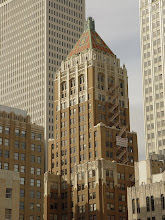http://findarticles.com/p/articles/mi_qn4182/is_20080616/ai_n26685773
Philtower in OKC goes greenJournal Record, The (Oklahoma City), Jun 16, 2008, by Kirby Lee Davis
Through its first decade, the Philtower claimed title to Tulsa's premier office building.
Manager River City Development LLC now intends to regain Class A status for downtown Tulsa's 80-year-old neo-gothic, art deco structure by investing in several expensive environmental improvements, helping the Philtower "go green" over the next 12 months.
It may even seek out certification from the Leadership in Energy and Environmental Design (LEED) program, said property manager Richard Winton.
"We would like to get that certification but we don't know if it's entirely feasible for a building of this age," he said.
What can be done will reduce annual operating costs by 20 percent or more, said Winton, who is accredited by the U.S. Green Building Council - a title that has earned him a sideline income as an environmental consultant.
"Part of going green was also to make the work environment more pleasant and healthier," said Winton. By improving both the quality of the air and the temperature controls, these improvements will make the working space more productive and valuable to tenants.
"These upgrades are very expensive and will gradually turn a Class B building into a Class A building," he said of its 119,126 square feet of office space. The building also provides several floors of condominiums.
These efforts put Philtower at the front end of a growing movement in Oklahoma, said analyst Darren Currin.
"A lot of buildings are going that route to gain Class A status," said the vice president and research director for OKC Property Research LLC. "But there are other factors to look at to gain Class A, from parking amenities to detail amenities, nice common areas. They're trying to do the same thing in Oklahoma City with First National. We've seen some buildings able to do that.
"It's kind of a popular trendy thing too to focus on the environment," he said. "Having that ability may attract some tenants who many not look at your building otherwise."
A March national report by CoStar Realty Information Inc. found environmentally friendly buildings outperformed non-green counterparts in occupancy, rental rates and sale price.
The study said LEED buildings claim a 4.1-percent higher occupancy rate over non-LEED competitors, while buildings that meet U.S. Environmental Protection Agency Energy Star standards obtain a 3.6-percent higher rate. LEED buildings command rent premiums of $11.33 per square foot, while Energy Star structures earn $2.40 more.
When sold, LEED structures draw $171 more per square foot than non-LEED facilities, while Energy Star structures earn an average of $61 per square foot.
"I think we're gradually starting to see it being adopted here," said Currin. "There's still some costs being associated with it. Some owners are still trying to see whether they will make that back."
Lowering green product costs also have encouraged some owners still watching to see if such investments bring higher occupancies.
"It's not as expensive to turn a building green as it was just a few years ago," he said.
Like many businesses, River City is refitting all Philtower lighting needs to the latest energy-saving florescent systems. With several thousand fixtures in its inventory, Winton said the transition cost about $50,000 - and should pay for itself within 18 months in lower electricity costs.
The management firm also is adding interior windows to the Philtower's 800 existing windows, at a cost of $200,000. This will improve the building's insulation and reduce leakage while not compromising the structure's historic integrity. Winton said that investment will pay for itself in two years.
That improvement will allow River City to downsize its boiler capacity by 50 percent, said Winton. To save even more money, River City is installing newer, higher capacity boilers at a cost of $65,000.
Along the same line, River City is seeking bids for installing new chillers to improve the building's air conditioning efficiency.
To better manage both, the 24-story tower received a new heating and air conditioning management system, at a cost of $50,000.
To improve its sustainability, Third Class Engineer Chris Green said River City preserves all possible wood paneling, doors, brass fixtures and other elements from its renovated offices, halls and interior spaces, reusing the materials when possible.
One targeted green element has evaded Winton's efforts.
"Right now for commercial buildings, we have yet to find a company that picks up and recycles waste," he said. "Hopefully that will get somebody to call, because we haven't found anything."
Copyright 2008 Dolan Media Newswires
Provided by ProQuest Information and Learning Company. All rights Reserved.
skip to main |
skip to sidebar



Twitter Updates
Simply Stated By RealSimple.com
Real Simple Blogs: Technology
Boston Building - Chic Downtown Tulsa Office Building
Urban Tulsa Weekly | News : City, State, County, Education
Followers
Subscribe Now: Feed Icon
Philtower on YouTube
HGTV's "Design Happens"
Yahoo Buzz
eTips
Decidio.com
| FEATURED VENDOR Tulsa, Oklahoma Banquet Facilities Directory at Decidio.com |
Philtower LoopNet Listing
Loft Bedroom

Loft Dining Room

TulsaWorld.com - News
Blog Archive
About

- River City Development
- Tulsa, OK, United States
- Homepage: www.thebostonbuilding.com www.philtower.com 918.584.0331


